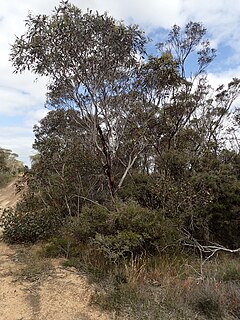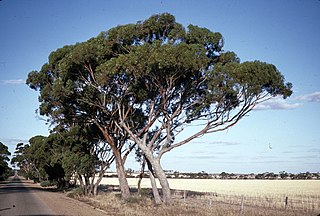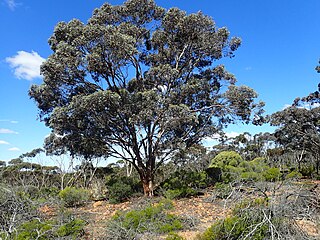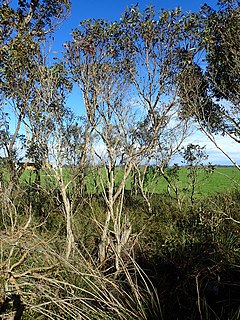Eucalyptus exigua is a species of mallee that is endemic to Western Australia. It has smooth, whitish bark, linear to narrow lance-shaped adult leaves, flower buds in groups of between seven and eleven, white flowers and short barrel-shaped to conical fruit.
Eucalyptus glomerosa, commonly known as jinjulu, is a species of mallee that is endemic to inland Australia. It has rough, fibrous and flaky bark near the base, smooth bark above, egg-shaped to lance-shaped adult leaves, flower buds usually in groups of seven, cream-coloured flowers and conical to hemispherical fruit. It is mainly found in the Great Victoria Desert of South Australia but also grows in eastern parts of Western Australia.

Eucalyptus hebetifolia is a species of mallee that is endemic to southern Western Australia. It has smooth grey and brownish bark with loose ribbons of bark near the base, lance-shaped adult leaves, flower buds in groups of up to thirteen, creamy white flowers and conical to barrel-shaped fruit.
Eucalyptus histophylla is a species of mallee or small tree that is endemic to southern Western Australia. It has smooth bark, often with ribbons of shed bark, linear to narrow lance-shaped adult leaves, flower buds arranged in groups in leaf axils, white flowers and cylindrical to barrel-shaped or conical fruit.
Eucalyptus incerata, commonly known as Mount Day mallee, is a species of mallee that is endemic to southern Western Australia. It has smooth bark, lance-shaped adult leaves, flower buds with a long, horn-shaped operculum and arranged in groups of seven, yellow flowers and barrel-shaped to cup-shaped fruit.
Eucalyptus livida, commonly known as wandoo mallee, is a species of mallee or small tree that is endemic to Western Australia. It has smooth bark, lance-shaped adult leaves, flower buds in groups of eleven or more, creamy white flowers and barrel-shaped fruit.

Eucalyptus luteola is a species of mallee that is endemic to a small area of Western Australia. It has smooth grey bark with rough greyish ribbons near the base, linear to narrow lance-shaped adult leaves, flower buds in groups of eleven to thirteen, lemon-coloured flowers and cylindrical to barrel-shaped fruit.
Eucalyptus microschema is a species of small, shrubby mallee that is endemic to the southwest of Western Australia. It has smooth, silvery grey bark, linear adult leaves, flower buds in groups of nine or eleven, white flowers and short, barrel-shaped fruit. It is restricted to a small area near Newdegate.
Eucalyptus olivina is a species of mallee or a tree that is endemic to Western Australia. It has smooth greyish bark, linear to narrow lance-shaped adult leaves, flower buds in groups of seven or nine, creamy white flowers and short barrel-shaped to cup-shaped fruit.
Eucalyptus perangusta, commonly known as fine-leaved mallee, is a species of mallee that is endemic to a small area on the south coast of Western Australia. It has smooth bark, glossy green, linear leaves, flower buds in groups of seven or nine, creamy white flowers and short, barrel-shaped fruit.

Eucalyptus phaenophylla, also known as common southern mallee, is a species of mallee that is endemic to Western Australia. It has smooth bark, linear to narrow lance-shaped or narrow elliptical adult leaves, flower buds in groups of up to thirteen, pale lemon-coloured flowers and barrel-shaped, cylindrical or conical fruit.
Eucalyptus pluricaulis, commonly known as the purple-leaved mallee, is a species of mallee that is endemic to Western Australia. It has smooth bark, dull bluish green, lance-shaped leaves, flower buds in groups of between nine and fifteen, pale yellow flowers and cylindrical to barrel-shaped fruit.
Eucalyptus polita is a species of mallet or small tree that is endemic to the southwest of Western Australia. It has smooth, greyish bark, narrow lance-shaped adult leaves, flower buds in groups of between seven and eleven, white flowers and cup-shaped fruit.
Eucalyptus subangusta is a species of tree, mallee or mallet that is endemic to the southwest of Western Australia. It has smooth bark, narrow lance-shaped leaves, flower buds in groups of up to nineteen, white flowers and cup-shaped to barrel-shaped fruit.
Eucalyptus thamnoides is a species of mallee that is endemic to south western Western Australia. It has smooth bark, lance-shaped adult leaves, flower buds in groups of seven, cream-coloured to pale yellow flowers and cup-shaped, conical or bell-shaped fruit.

Eucalyptus aequioperta, commonly known as the Welcome Hill gum, is a mallee, sometimes a tree and is endemic to Western Australia. It has rough bark on the lower half of the trunk, lance-shaped leaves, flower buds in groups of between seven and fifteen, white flowers and more or less cup-shaped fruit.

Eucalyptus captiosa is a species of mallee that is endemic to the south-west of Western Australia. It has smooth bark, lance-shaped adult leaves, groups of three or seven, slightly ribbed flower buds arranged in leaf axils, pale yellow flowers and cup shaped fruit.

Eucalyptus densa is a species of mallee or mallet that is endemic to Western Australia. It has smooth greyish bark that is shed in curly strips, linear to narrow lance-shaped adult leaves, long, spindle-shaped flower buds in groups of seven or nine, pale yellow or lemon-coloured flowers and conical, cylindrical or barrel-shaped fruit.

Eucalyptus alatissima is a mallee that is endemic to central parts of the Great Victoria Desert. It has rough bark on the lower part of its stems, smooth tan to cream-coloured bark on its upper parts, egg-shaped to lance-shaped leaves and buds in groups of three. The buds have a powdery covering and are prominently winged.

Eucalyptus adesmophloia is a mallee that is endemic to the south-west of Western Australia. Its fresh bark is grey, the leaves are a glossy dark green, the flowers are white and borne in large groups, and the fruits are conical to hemispherical.







